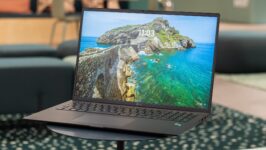
LG Gram 17 (2023) review: Blows hot and cold
LG ships the Gram 17 with a DCI-P3 ICC colour profile that you can activate using the LG Smart Assistant control panel. Measuring the colour accuracy against the DCI-P3 profile gave a Delta E variation of 3.02, which is rather high. Reverting to the standard Windows colour profile, the variation dropped to 2.9 vs sRGB which is below the magic number 3, but only just.
The speaker system, meanwhile (a 2 x 2W affair) has been tuned with quality rather than absolute volume in mind. Maximum volume measured against a pink noise source at a 1m distance is a pretty meagre 66.3dB(A) but there’s a surprising amount of bass in evidence and plenty of detail.
The low-ish volume means you can happily leave the volume set to the maximum without having to worry about the sound getting raucous. I’m listening to the new Everything But The Girl album, Fuse, as I write this and it sounds very good on the LG Gram 17 thanks to a rich and resonant soundscape that belies the basic specification.
READ NEXT: The best cheap laptops to buy for those on a budget
LG Gram 17 (2023) review: Performance and battery life
When it comes to performance it’s very much a game of two halves because the LG Gram 17 suffers from thermal throttling issues that only become apparent in some benchmark tests or tasks, namely ones that take a long time to run and continually use all the Core i7-1360P’s 12 cores.
Our in-house 4K multi-media test is a punishing affair that takes about 20 minutes to run and offers the CPU no chance to cool or recuperate. The Gram 17 scored 163 points in this test, which is worse than the Samsung Galaxy Book3 Pro we tested with a less powerful Intel Core i5-1340P and only 8GB of RAM. The difference is that, after only a few minutes, thermal throttling kicked in and the CPU utilisation dropped to around 40% and stayed there.
The Cinebench R23 multi-core test tells a similar story, scoring 9,159 on the Samsung but only 8,069 on the nominally more powerful LG. Those tests were run with the LG’s cooling system in High rather than Normal mode, but this didn’t make much difference.
However, if you look at the GeekBench 5 and 6 scores, tests that run in a much shorter time and pause momentarily between jobs for the CPU to cool, they show the LG to be, as expected, faster than the Samsung with multi-core scores of 9,575 and 10,445 to the Samsung’s 8,699 and 9,772. In both the Geekbench and Cinebench single-core tests, the LG gave the Samsung a pasting because heat didn’t become an issue.
In everyday use, you don’t really notice the throttling because few tasks will cause it to kick in as aggressively as this, and the sorts of jobs that do – like rendering video files or gaming – arguably have no place running on an ultraportable like the LG Gram 17. This LG then is more of a Usain Bolt than a Mo Farah: quick in a sprint, more pedestrian over a distance.
Graphics performance proved immune to any thermal issues with the Metro: Last Light Redux benchmark running at 49.9fps at 1,920 x 1,080, a healthy advantage over the Galaxy Book3 Pro’s 24fps, with no noticeable difference between the first and last of ten test runs.
And, fortunately, the thermal issues never caused the outside of the Gram 17 to get overly warm (no part of the exterior rose above 38°C) and, even when the fans were running at full speed, the noise they made was barely noticeable.
And the flip side is that, when it comes to battery life, the LG Gram 17 performs very well. In our standard video rundown test using VLC with the display set to 170cd/m2 and flight mode engaged, the 80Wh battery kept the lights on for 10hrs 12mins, which is a good result for a Windows laptop, though a long way short of the MacBook Air’s 17hrs.



